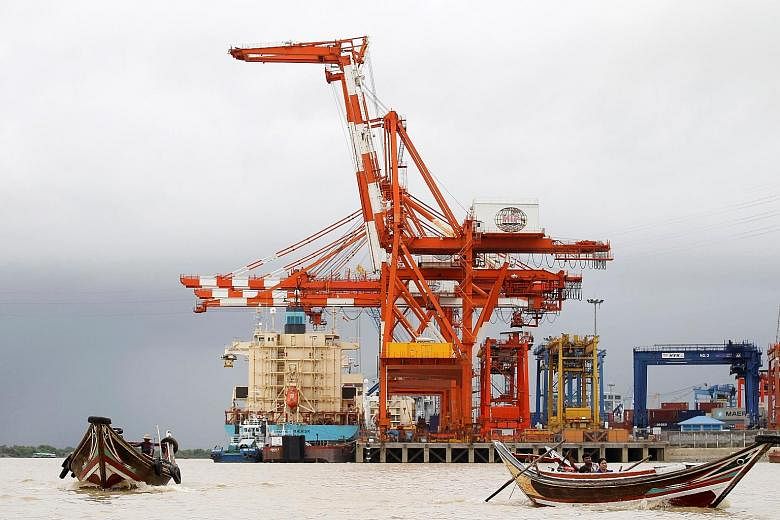YANGON • Myanmar's new government has been grappling with its first economic management crisis, as a weeks-long traffic jam of cargo ships at the country's biggest port threatens to scare potential investors away and choke off nascent economic growth.
The bottleneck at the dilapidated port was caused by a spike in demand for goods as the opening up of the economy accelerates following a historic election win by Ms Aung San Suu Kyi's National League for Democracy (NLD) in November.
"Because of the general growth of the economy, we are packed. The ships have nowhere to go," said Ms Ma Cherry Trivedi, managing director of Ayudroma International, an adviser to Myanmar Industrial Port (MIP), which experienced the worst congestion.
Myanmar boasts one of the world's fastest-growing economies, expanding at 7 to 8 per cent in the years since the military relinquished direct control in 2011.
But its main port has changed little since the end of British colonial rule nearly 70 years ago - emblematic of ramshackle infrastructure that could hold back the foreign investment Ms Suu Kyi needs to live up to sky-high expectations and remake a country impoverished by decades of junta rule.
The number of ships docking in Yangon has doubled over the past decade and the number of containers has jumped fourfold, data shows, clogging up inadequate storage space, overwhelming sclerotic logistics systems and delaying deliveries.
Western shipping lines are largely confined to a single creaky terminal within the port because of reluctance to use facilities operated by Asia World, whose majority owner, Mr Steven Law, remains subject to United States sanctions.
The tipping point into the crisis came when MIP miscalculated the volume of incoming shipments before a three-week holiday in April, when the country largely shut down, shipping companies operating at the terminal said.
That meant up to 10 ships faced delays of as long as two weeks to have their cargoes unloaded, causing the biggest jam the port had seen in modern times.
Industry sources said the hold-up cost major shipping lines millions of dollars a week.
"There was no proper cooperation between shipping lines, container storage facilities and terminal operators. Chaos," said Mr Aye Lwin, joint secretary-general of Myanmar's Chamber of Commerce, who was involved in efforts to resolve the jam.
Myanmar's presidential office announced emergency measures in the middle of last month to tackle the congestion, including 24-hour port operation and Customs clearance, and ordered daily reports from the ministers of commerce and transport.
By Thursday, the backlog had been largely cleared, Ms Ma Cherry Trivedi said, although additional staff flown in by shipping lines to help manage the situation remained in place, as did the emergency measures, to prevent cargoes from piling up once more.
Mr Tatsuya "Ricky" Ueki, managing director at shipping company MOL Myanmar, said the port infrastructure has not caught up with the economic development of the country.
"There's no easy way out of this, but billions of dollars in the country's development hinge on how aggressive the government is in solving the problem," said Mr Ueki.
REUTERS

